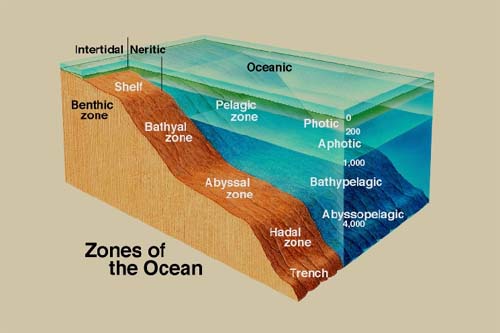- Zonation
of the Marine Environment

Global
Seafloor Topography

The abbyssal plains are not only
flat plains but exhibit deep-sea mounts and long ridges of midoceanic ridges.
The global topography of the sea floor became only known after special
techniques of satellite measurements were made possible in the late 1990's.
Classification of the Marine Environment
- Classification by light
- Photic and aphotic
- Phytoplankton need light to photosynthesize and can only thrive in the photic zone
- Zooplankton (animals) and bacteria do not need light and inhabit the oceans down to the deep-sea floor
- Classification by location
- Water and sea floor divided into specific zones: benthic & pelagic
- By water depth divided into coastal, neritic, oceanic
- Each has distinct physical and chemical characteristics
- Each supports different organisms
- Plankton (Pelagial)
- Floaters and drifters, have to move with water currents
- Plants and animals and protists and bacteria (free, attached); range from microscopic size to several meters in length (jellyfish)
- Plants and photosynthetic cyanobacteria = phytoplankton Animals = zooplankton; bacteria = bacterioplankton
- Also differentiation according to size: pico-, nano-, micro-, meso-, macro-, megaplankton. Size does NOT separate plankton from nekton
- Nekton (Pelagial)
- Free swimmers, can overcome currents and move against them
- Animals (large crustaceans, fish, mammals)
- Benthos (Benthal)
- Attached to, on, or in the sea floor
- Plants and animals and protists and bacteria (range from microscopic size to several meters in length (kelps)

The discovery of very small (<2 µm) cyanobacteria as ubiquitous and
abundant inhabitants of the oceans between 1979 and 1989 led to extending
the size range of phytoplankton into the picoplankton size range. We know
today that the picoplanktonic phytoplankton is a major component in all
warm-water marine systems, and their discovery changed our perception of
marine food webs substantially. Phytoplankton occurs in three size classes:
--
picoplankton: 0.2 - 2.0 µm
--
nanoplankton: 2 - 20 µm
--
microplankton: 20 - 200 µm
Living
on the fast lane?
r-
and k- selection
|
|